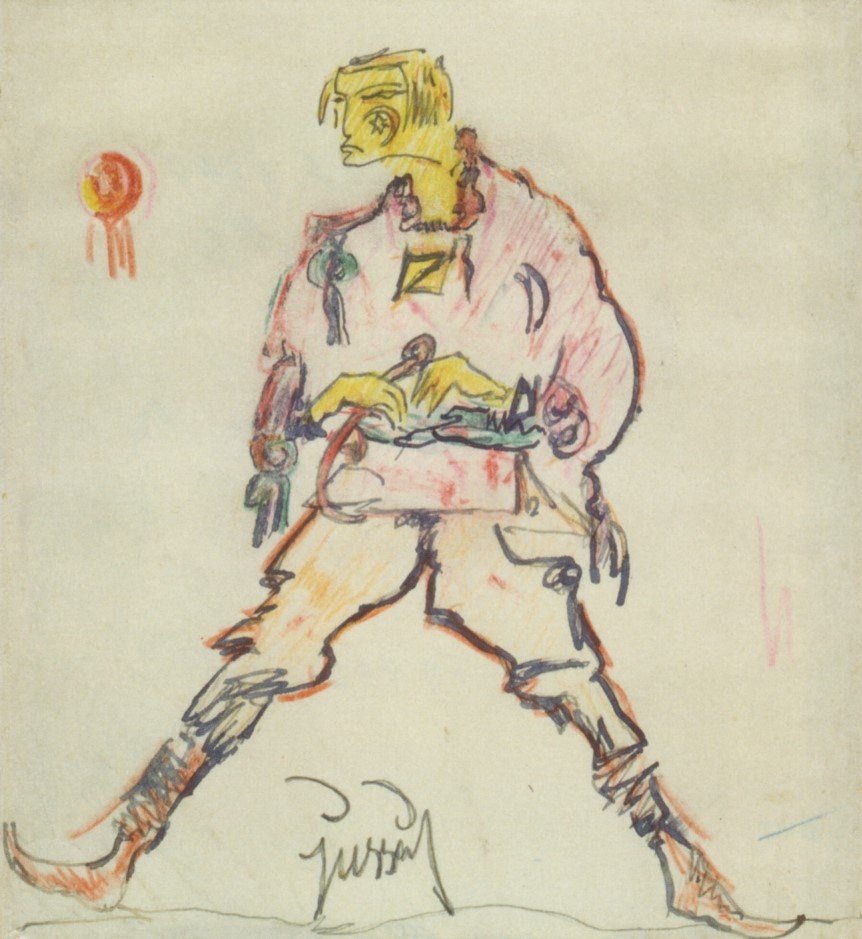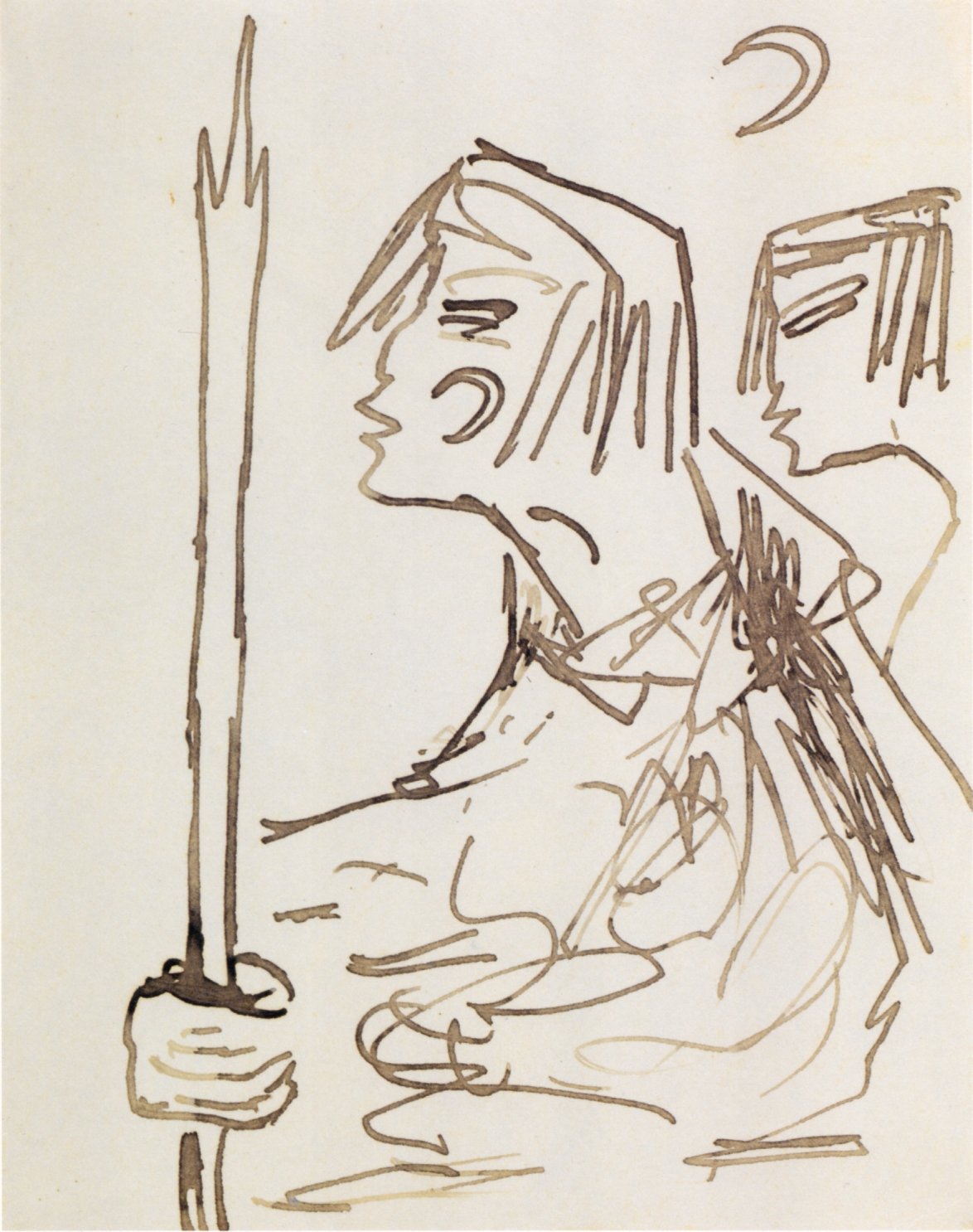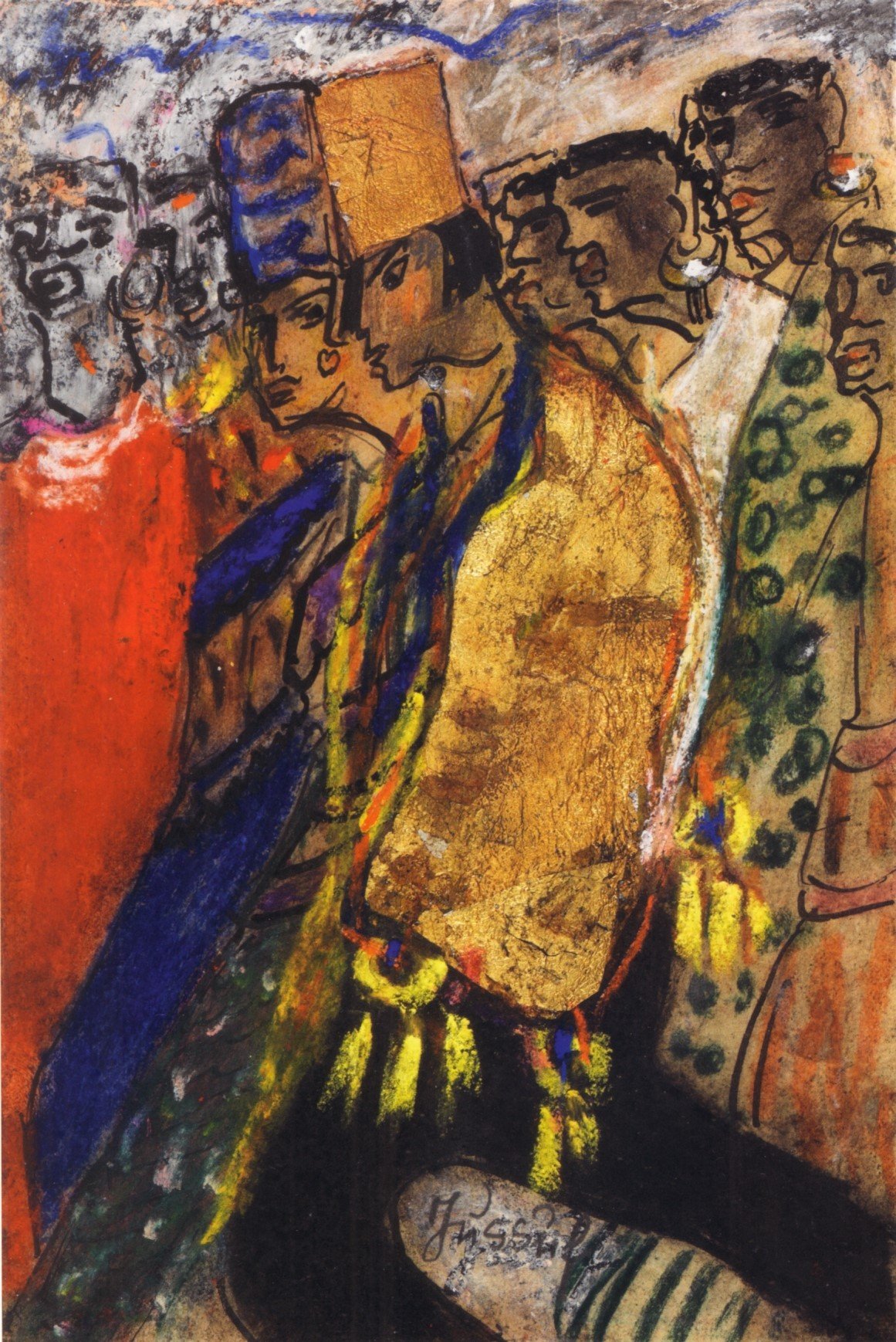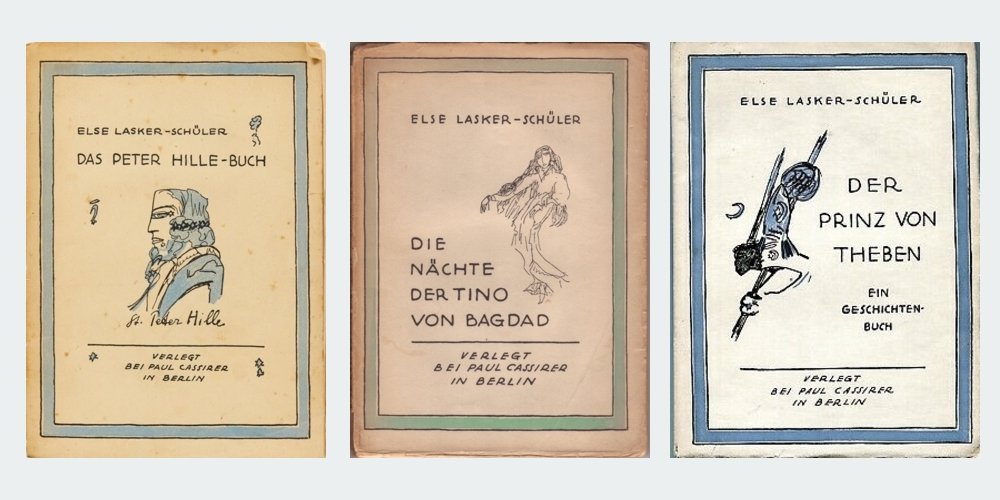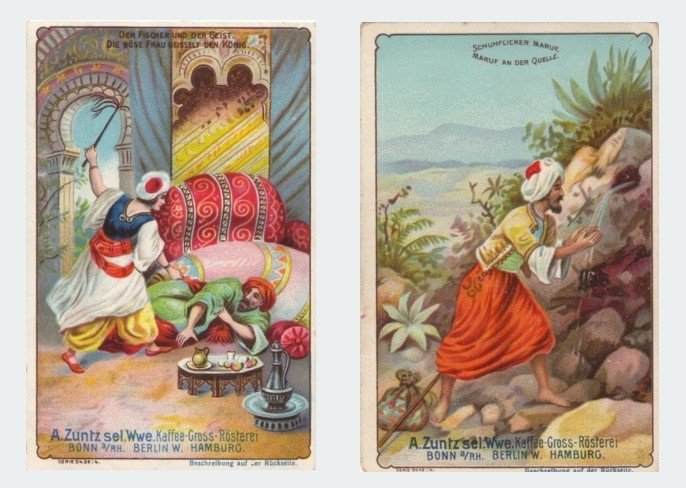Arno Holz & Johannes Schlaf
A Farewell
translated by James J. Conway
‘Well aren’t you dull today!’
Little Emmi bent her fine, round head low over her coarse, grey wool stockings once more. The slender steel needles in her hands jingled softly, the moonlight reflected in them gleamed.
Her small, red lower lip was protruding slightly. She was pouting!
Heinz had not even answered. He was still standing at the other window, looking down at the laneway.
He had bent the flower pots slightly to one side.
Their black, grotesque shadows stood out behind him on the scrubbed floorboards. Next to them, to the right and left, the two curtains wove their lacy garlands.
How fine the little nest was! How fine!
His forehead was now pressed firmly against the panes.
In the distance, on a small, octagonal oriel, he could clearly distinguish a large, coal-black weathercock. It looked as though it had just this moment crowed. A small hole had been punched into its round, iron head as an eye, and its strangely ornate tail feathers jagged sharply into the moonlight.
Behind it a cat was climbing up a drainpipe. Now it disappeared behind a chimney. Below it was a withered tuft of grass waving like a tongue from a tin dragon head …
Heinz now let the myrtle stem snap back again without thinking.
A small black bat had just touched the pane with its wing.
The old, shrivelled nest had never seemed so strange to him.
Downstairs, outside, there were still plenty of people. Women gossiping about their dear neighbours, philistines smoking their long pipes, children who had already fallen asleep on their mothers’ laps.
The small, round master baker Klüsener had made himself comfortable on a garden chair. His broad, red apple face was clearly visible diagonally across the laneway. His coat was white, snow white. Just like his apron.
Before him stood fat Ramschüssel, chatting with him. The silver-plated tip of his helmet gleamed every time he turned.
‘Well you could at least play me something on the piano!’
Heinz winced a little, instinctively.
She looked over at him in astonishment.
What was wrong with him today? She couldn’t make sense of him at all!
He was now seated on the small, round swivel armchair which was covered in black patent leather. The moonlight reflected in the black sheen of the instrument. It dripped like gold from the fantastical arabesques of the two rotating brass candle holders. It lay like plated silver in the small disc in between. From its centre hunched Beethoven’s angular medallion, black as a black man’s head. Little Emmi instinctively dropped down deep into her aunt’s large, rattan armchair. Her round, white hands lay casually on her lap. She looked over at him with her eyes wide open, as though she were dreaming.
Heinz now bent down. The lid was folded back. The slight vibration that ran through the metal strings reverberated throughout the whole room.
For a moment all was still. The regulator ticked. The quaking grasses nodded in the two vases above.
Then his fingers slid over the keys. The melody was soft, muted.
‘At the Well before the Gate!’ Little Emmi sat there, motionless. How pale he was today!
He looked out the window as he played, the moonlight was now falling full on his face.
Little Emmi instinctively bent forward again.
His hands now slid off the keys.
The last note faded away.
The regulator ticked again and the quaking grasses nodded.
‘“At the Well before the Gate!” But that is so sad! You really are horrid today!’
Little Emmi said this in a very low voice.
‘Why don’t you play …’
She put the knitting needle thoughtfully to her little red mouth.
‘Wait! … Why don’t you play … something really jolly! … Well? For instance … “Where a Little Cottage Stands” or something like that!’
Heinz played. Once more he had not replied.
The moonlight now filled the whole room …
Suddenly little Emmi shuddered. A shrill, ragged sound rang out through the room, and the back of the small, leather swivel armchair hit the floorboards. Heinz leapt up.
‘Damned music!’
He was now standing again, his hands in his pockets, by the window.
Little Emmi was trembling all over.
The poor, poor boy!
She felt herself turning pale.
Now she lay her hand lightly on his shoulder.
‘Tell me!’
She could not continue.
‘There!’
Heinz had torn the damned letter from his pocket.
‘There!’
He held it out to her, facing away.
Then he pressed his head against the window frame again and looked down at the quiet, moonlit laneway …
Little Emmi stood there with the letter for a moment, perplexed. Then she returned to her window and held it right up to the pane. The moonlight now fell full on the solid black lines.
‘Dear boy!’ …
The paper in her hand trembled slightly.
… ‘Dear boy! When you come for your long holiday, pack all your things with you this time.’
She felt her heart pound!
‘I believe I am only doing you a favour, by … by taking you … out of that nest.’ …
Her arm had sunk down limply on the window sill. She had to support herself. She pressed the letter against her chest.
‘I believe I am only doing you a favour by taking you out of that nest!’
Now she looked over at Heinz. He was still leaning against the window frame. She thought she saw him shrugging his shoulders slightly.
‘For a few semesters I plan… to you send to Berlin’ …
To Berlin!
Mechanically she read on.
‘You will have the best experts for your disciplines there. And beyond that, it would not hurt you to stick your nose into the wider world a little.’ …
Oh yes! Into the wider world! The wider world!
Outside there was a slow rumbling over the bumpy old cobbles up the steep laneway.
‘So must I, so must I, leave the village with a sigh?’
The postilion blew his horn into the quiet evening. Far, far above the pointed bay windows and roofs a few white stars were shining.
‘The purpose of your stay in the nest – to give you a few jolly semesters – has, I feel, been sufficiently accomplished.’ …
‘I cannot imagine, apart from your studies, what other major advantages for your further education might derive from your continuing to stay there. Your mother and your siblings send their greetings.
Your father.’
The page slid out of her hands and rustled on the floorboards. It lay there like a garish white spot in the middle of the image of the window that the moon had painted on the floor.
It was deathly quiet in the room. Only the dark brown regulator ticked; evermore, evermore! The round, shiny brass disc of the pendulum moved evenly back and forth. The lacquer sticks on the windowsill exuded a numbing fragrance. The frame and the glass of the wide, round mirror above the mirror and the green tiles of the large stove shimmered indistinctly in the half light. Gentle reflections of the moonlight shone from the curved backs and the yellow wickerwork of the chairs.
Little Emmi sank back into the big armchair. She stared at the gold-plated, woven sewing basket next to her on the window sill between the flower stems.
Her hands lay limp on her lap.
Suddenly she came to again. Heinz had thrown himself down before her. His black curly hair lay on her knees …
‘Emmi!’
She could not respond. She closed her eyes tightly.
After a while, once more, quietly, timidly:
‘Emmi!’
She was trembling all over.
Heinz now quickly raised his head. There were warm drops on his hand …
‘Dear, dear Emmi!’
He now embraced her and kissed her full on her round, small mouth.
‘No! …’ No!’
She turned red all over. He wasn’t listening to her.
He now hugged her very tightly and kissed her. On the cheeks, on the mouth, on the forehead. Over and over! …
Suddenly little Emmi looked at the window, startled. Something had knocked softly on the window.
A night butterfly! …
A shiver ran through her. Gently she pushed Heinz back.
In the alleyway below several doors closed. Someone shouted distinctly across the street: ‘Good night!’ Now someone was coming round the corner, singing: ‘Free is the lad!’
They were both listening.
‘Emmi! I will stay! I will stay!’
He took both her hands and squeezed them.
‘But if your father wills it?’
‘Oh, it is so fine here! So fine!’
The singing continued. From a distance. From far, far away …
She did not respond. Heinz was still clutching her hands. Now she looked sideways at the floorboards. Her eyes had just fallen on the letter. It was still lying motionless like a garish white spot on the floor, on the image of the window. The solid black signature stood out clearly from the white paper: ‘Your father!’
‘Do you see? It’s no use! It’s no use!’
Heinz looked at her, most frightened.
‘I will not forget you! Never!’
‘Forget! Forget! How you talk! How stupid we are anyway! How stupid! As though we were saying goodbye forever! Forever!’
Without meaning to he now followed her gaze. Now he too saw the letter.
‘Oh! That damn letter!’
He leapt back to his feet now.
He picked up the paper.
‘There! Well? There! There!’
He tore it into a thousand pieces. The small, white flakes swirled all over the dark room. Little Emmi watched him, very frightened.
He was now standing upright before her.
‘Not forever!’
He embraced her again.
‘Not forever, dear Emmi! We will write to each other every week! Several times! No?’
She just nodded.
‘Emmi! … Tell me!’
‘Yes! Yes!’
‘And for the last semesters I will come back here! And then … and then … you know! … Emmi! No? You see?’
‘Quiet! Quiet!’
She leaned over him now. She kissed his forehead.
Again she looked at him with her large eyes. So strange!
Outside the evening wind was now blowing through the quiet little moonlit laneway. The metal sign below creaked. At times it creaked against the window pane. Softly, softly. So softly …








